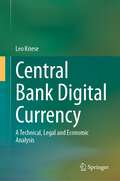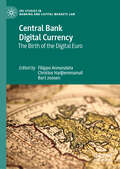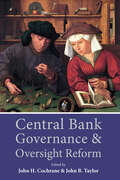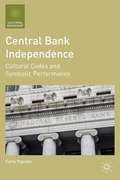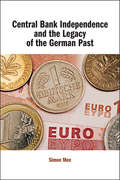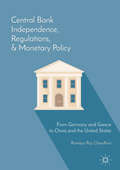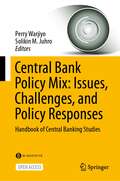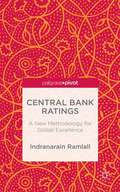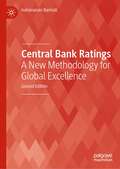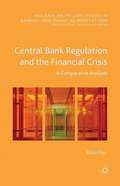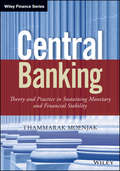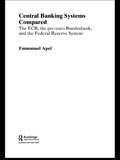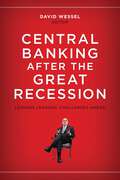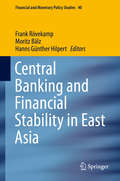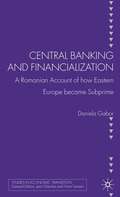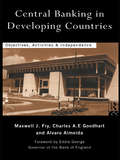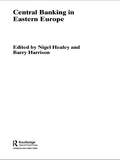- Table View
- List View
Central Bank Collateral Frameworks: Principles and Policies
by Simon Gray Alexandre Chailloux Rebecca MccaughrinA report from the International Monetary Fund.
Central Bank Digital Currency: A Technical, Legal and Economic Analysis
by Leo KrieseThis book offers a deeper understanding of digitisation and innovative technologies in the financial sector. It focuses on a digital version of sovereignly created money that is accessible to the broad public. This central bank digital currency (CBDC) raises several questions. Will CBDC lead to public surveillance of the citizens? What is digital money in the legal sense? And what is the difference to already existing forms of digital money? This book addresses main questions associated with central bank digital currency by providing background information as well as in-depth analyses. The book introduces a basic understanding of innovative technologies such as the distributed ledger technology. It shows how a system of money can be created and what roles each participant has. Taking an economic point of view, the book demonstrates the monetary policy in the euro area and examines how a digital version of public money could affect the transmission mechanism as well as the financial stability. Could CBDC lead to a "digital bank run"? Could it replace the established financial intermediaries such as banks? What would that mean to the economy?Mainly, the book focuses on the legal issues of CBDC. Which is the competent institution for establishing digital public money? Will digital money change the way of how we handle financial data? Also, the book examines the legal usability of CBDC in the economy. How can digital money based on innovative technologies be transferred in accordance with the law? Can a debtor of a monetary claim flee into the digital currency? This book addresses the public and private sector participants as well as the legislators on how to handle CBDC. Most important, the book addresses everyone interested in digitisation and innovative financial technology who wants to gain a deeper understanding of the next big evolvement of money.
Central Bank Digital Currency: The Birth of the Digital Euro (EBI Studies in Banking and Capital Markets Law)
by Filippo Annunziata Christos Hadjiemmanuil Bart JoosenThis book looks at the new phenomenon of Central Bank Digital Currency (CBDC) with a focus on the launch of the Digital Euro in the European Union. It contains treatment of the subject of CBDC from various perspectives, with each of the authors formulating viewpoints regarding this new phenomenon. It also offers an insightful assessment of the legal status of a central bank digital currency, engaging in the theoretical effort of testing the legal implications of the birth of a digital complement to cash. The chapters focus on the rationale for a digital Euro, its ability to aid financial inclusion, the constitutional foundations of the CBDC, demands of a digital euro on the side of the beneficiaries of the retail payment system, and the “mechanics” of the CBDC in relation to its issuance and governance. It will be of interest to financial services, banking, financial regulation, and monetary policy researchers and scholars alongside lawyers and policymakers.
Central Bank Financial Strength and Policy Performance: An Econometric Evaluation
by Ulrich Klüh Peter StellaA report from the International Monetary Fund.
Central Bank Governance and Oversight Reform
by John H. Cochrane and John B. TaylorA central bank needs authority and a sphere of independent action. But a central bank cannot become an unelected czar with sweeping, unaccountable discretionary power. How can we balance the central bank's authority and independence with needed accountability and constraints? Drawn from a 2015 Hoover Institution conference, this book features distinguished scholars and policy makers' discussing this and other key questions about the Fed. Going beyond the widely talked about decision of whether to raise interest rates, they focus on a deeper set of questions, including, among others, How should the Fed make decisions? How should the Fed govern its internal decision-making processes? What is the trade-off between greater Fed power and less Fed independence? And how should Congress, from which the Fed ultimately receives its authority, oversee the Fed? The contributors discuss whether central banks can both follow rule-based policy in normal times but then implement a discretionary do-what-it-takes approach to stopping financial crises. They evaluate legislation, recently proposed in the US House and Senate, that would require the Fed to describe its monetary policy rule and, if and when it changed or deviated from its rule, explain the reasons. And they discuss to best ways to structure a committee—like the Federal Open Market Committee, which sets interest rates—to make good decisions, as well as offer historical reflections on the governance of the Fed and much more.
Central Bank Independence
by Carlo TognatoBy engaging in an ethnography of the social text of German, European and USA monetary affairs, this book introduces a new analytical framework that will enable practitioners and academics, particularly within sociology, economics, political economy, and political science, to gain a clear understanding of the role of culture in central banking.
Central Bank Independence and Transparency: Evolution and Effectiveness
by Christopher Crowe Ellen E. MeadeA report from the International Monetary Fund.
Central Bank Independence and the Legacy of the German Past
by Simon MeeThe 2008 financial crisis led to more and more frequent political attacks on central banks. The recent spotlight on central bank independence is reminiscent of the fiery debates amongst Germany's political elites in 1949 on the same issue; debates that were sparked by the establishment of West Germany in that year. Simon Mee shows how, with the establishment of West Germany's central bank - today's Deutsche Bundesbank - the country's monetary history became a political football, as central bankers, politicians, industrialists and trade unionists all vied for influence over the legal provisions that set out the remit of the future monetary authority. The author reveals how a specific version of inter-war history, one that stresses the lessons learned from Germany's periods of inflation, was weaponised and attached to a political, contemporary argument for an independent central bank. The book challenges assumptions around the evolution of central bank independence with continued relevance today.
Central Bank Independence, Regulations, and Monetary Policy: From Germany And Greece To China And The United States
by Ranajoy Ray ChaudhuriThis book examines the linkage between central bank structure, central bank autonomy—with respect to setting its monetary policy goals, choosing its policy mechanisms, legal independence, and financial independence—and monetary policy, both in select benchmark countries and at a broader theoretical level. Country-specific chapters on the US, UK, Germany, Greece, Russia, India, China, Japan, Brazil, and South Africa focus on the history, administrative structure, and independence of the central monetary authority in these countries. The chapters go on to explore the countries’ conduct of monetary policy, their interplay with political forces and the wider economy, their currency, and their macroeconomic outcomes. The book will appeal to researchers, students of economics, finance and business, as well as general readers with an interest in the subject.
Central Bank Policy Mix: Handbook of Central Banking Studies
by Perry Warjiyo Solikin M. JuhroThis is an open access book.This book is an integration of keynote speeches, lectures, and related teaching materials during the five years of the "Central Bank Policy Mix: Issues, Challenges and Policy Responses" flagship program of the BI Institute, the learning and research centre of Bank Indonesia. The book examines the interactions among central bank policies including monetary policy, exchange rate policy, macroprudential policy, and capital flow management and also elaborates on modeling issues and quantitative analysis of the interaction between macroeconomic variables and policy instruments.
Central Bank Ratings: A New Methodology For Global Excellence
by Indranarain RamlallWhen the global financial crisis broke, central banks in both the US and the UK undertook massive asset purchase programmes which resulted in considerable increase in assets. Cross-border spillover effects were noted across global economies. Balance sheet adjustments may eventually gnaw at the profit-earning capacities of central banks, and in extreme cases, negative equity can manifest.
Central Bank Ratings: A New Methodology for Global Excellence
by Indranarain RamlallWhen the global financial crisis broke, central banks in both the US and the UK undertook massive asset purchase programmes which resulted in considerable increase in assets. Cross-border spillover effects were noted across global economies. Balance sheet adjustments may eventually gnaw at the profit-earning capacities of central banks, and in extreme cases, negative equity can manifest. This updated book investigates a benchmark for comparing central banks. The author employs a unique and large set of metrics to gauge the quality of central banks and presents an argument to reflect upon international best practices covering 124 banks in this latest study. The study uses different criteria including the accounting body, research, presence of stress-testing exercises, inflation-targeting frameworks, staff efficiency, and languages of communication with the public, amongst others. The book begins by providing an overview of central banking, before exploring some stylized facts about central banks in unique detail. It then presents a ratings methodology for worldwide central banks to analyse the results. A backtesting exercise is included to validate the quality of the ratings obtained. The book concludes by offering insights into the comparison of central banks.
Central Bank Reforms in the Baltics, Russia, and the Other Countries of the Former Soviet Union
by John Dalton Gabriel Sensenbrenner Malcolm Knight Susana Aimuiña Inci Otker Ceyla Pazarba io lu Arne B. Petersen Peter Quirk Nicholas M. Roberts Jan Willem van der VossenSince 1991, the 15 countries under review - have to varying degrees, been pursuing reforms whose broad objectives have been to achieve market-based determination of interest rates and exchange rates, manage banking system liquidity through market operations with indirect instruments, and provide the institutional underpinnings for the design and implementation of macroeconomic stabilization and structural reform programs supported by the IMF. This study reviews the experience under these programs and the economic developments in the countries that undertook them.
Central Bank Regulation and the Financial Crisis: A Comparative Analysis (Palgrave Macmillan Studies in Banking and Financial Institutions)
by Miao HanThe respective legal frameworks that control central banks are shaped by whether they are market oriented or government controlled. However such stark distinction between these two categories has been challenged in view of the varying styles of crisis management demonstrated by different central banks during the crisis. This book uses comparative analysis to investigate how the global financial crisis challenged the role played by central banks in maintaining financial stability. Focusing on four central banks including the US Federal Reserve System, the Bank of England, the Bank of Japan and the People's Bank of China, it illustrates the similarities between the banks prior to the crisis, and their similar policy responses in the wake of the crisis. It demonstrates how each operated with varying levels of independence while performing very differently and facing different tasks. The book identifies some central explanatory variables for this behavior, addressing the mismatch of similar risk management solutions and varying outcomes. Central Bank Regulation and The Financial Crisis: A Comparative Analysis explores the legal challenges within central bank regulation presented by the global financial crisis. It emphasizes the importance of, and the limitations involved in, legal order and argue that in spite of integration and globalization, significant differences exist in central banks' approaches to risk management and financial stability.
Central Bank Response to the 2007-08 Financial Market Turbulence: Experiences and Lessons Drawn
by Ulrich Klüh Peter Stella Seiichi Shimizu Simon Gray Alexandre ChaillouxA report from the International Monetary Fund.
Central Bank: The ChexSystems(SM) QualiFile(R) Decision
by Peter Tufano F. Asis Martinez-Jerez Dennis Campbell Emily Mcclintock EkinsThe "Central Bank" series analyzes the use of information and product design for managing the counterparty risk of newly acquired customers. Central Bank, a mid-sized regional U.S. bank, was attempting to grow its customer base by increasing the number of new checking accounts. Like many banks, Central saw checking accounts as an important tool for customer acquisition and loyalty-building. However, the bank realized that the aggressive pursuit of new accounts could result in an increased number of overdrafts and, ultimately, customer defaults. The first case, "Central Bank: The ChexSystems(SM) QualiFile(R) Decision," analyzes how QualiFile, a debit scoring product commercialized by ChexSystems, can be used to manage this risk.
Central Banking
by Thammarak MoenjakUnderstand the theories and interpret the actions of modern central banks Central Banking takes a comprehensive look at the topic of central banking, and provides readers with an understanding and insights into the roles and functions of modern central banks in advanced as well as emerging economies, theories behind their thinking, and actual operations practices. The book takes a systematic approach to the topic, while providing an accessible format and style that is appropriate for general audiences and students with only a minimal macroeconomic background. Theoretical reviews and examples of how the theories are applied in practice are presented in an easy-to-understand manner and serve as a guide for readers to further investigate specific ancillary central banking topics and as a means to make informed judgments about central bank actions. Important topics covered in the book include:Evolution of central banking functions and the international monetary systemTheoretical backgrounds that are the foundation to the modern practice of monetary policyMonetary policy regimes, including exchange rate targeting, money supply growth targeting, the risk management approach, inflation targeting, and unconventional monetary policy.Actual practice in market operations and transmission mechanisms of monetary policyThe exchange rate and central bankingTheoretical backgrounds related to various dimensions of financial stabilityCurrent developments with regards to sustaining financial stabilityThe future of central banking in the wake of the 2007-2010 global financial crisisCase studies on relevant practical issues and key concepts in central bankingDesigned as essential reading for students, market analysts, investors, and central banks' new recruits, Central Banking better positions readers to interpret the actions of central banks and to understand the complexities of their position in the global financial arena.
Central Banking Systems Compared: The ECB, The Pre-Euro Bundesbank and the Federal Reserve System (Routledge International Studies In Money And Banking Ser. #Vol. 20)
by Emmanuel ApelThis new study provides a comprehensive survey of the recently established European financial system in comparison to previous European systems and the US Federal Reserve. This well-written contribution to financial economics should be of interest to academics as well as professionals concerned with financial systems around the world.
Central Banking after the Great Recession
by David WesselThe global financial crisis is largely behind us, but the challenges it poses to the future stability of the world's economic system affects everyone from American families to Main Street businesses to Wall Street financial powerhouses. It has provoked controversy over the best way to reduce the risk of a repeat of what proved to be the worst financial crisis since the Great Depression. To describe those challenges-and the lessons learned-the Hutchins Center on Fiscal and Monetary Policy at Brookings turned to frontline policymakers and some of their most prominent critics. Central Banking after the Great Recession contains the resulting research, leading off with a telling interview between Ben Bernanke, then in his final weeks as Federal Reserve chairman, and Liaquat Ahamed, author of the Pulitzer Prize-winning Lords of Finance. Insightful chapters by John Williams of the San Francisco Federal Reserve Bank, Paul Tucker of Harvard University, and Donald Kohn of Brookings discuss unconventional monetary policy, financial regulation, the impact of the crisis on the independence of the Federal Reserve. Each chapter is followed by a lively debate.Contents1. Introduction2. A Conversation with Ben Bernanke3. Monetary Policy When Rates Hit Zero: Putting Theory into Practice4. Regulatory Reform: What'a Done? What Isn't?5. Federal Reserve Independence after the Financial Crisis: Should We Be Worried?
Central Banking after the Great Recession: Lessons Learned, Challenges Ahead
by David WesselThe global financial crisis is largely behind us, but the challenges it poses to the future stability of the world's economic system affects everyone from American families to Main Street businesses to Wall Street financial powerhouses. It has provoked controversy over the best way to reduce the risk of a repeat of what proved to be the worst financial crisis since the Great Depression. To describe those challenges #151;and the lessons learned #151;the Hutchins Center on Fiscal and Monetary Policy at Brookings turned to frontline policymakers and some of their most prominent critics. Central Banking after the Great Recession contains the resulting research, leading off with a telling interview between Ben Bernanke, then in his final weeks as Federal Reserve chairman, and Liaquat Ahamed, author of the Pulitzer Prize-winning Lords of Finance. Insightful chapters by John Williams of the San Francisco Federal Reserve Bank, Paul Tucker of Harvard University, and Donald Kohn of Brookings discuss unconventional monetary policy, financial regulation, the impact of the crisis on the independence of the Federal Reserve. Each chapter is followed by a lively debate.
Central Banking and Financial Stability in East Asia (Financial and Monetary Policy Studies #40)
by Frank Rövekamp Moritz Bälz Hanns Günther HilpertThis book explores financial stability issues in the context of East Asia. In the East Asian region financial stability has been a major concern ever since the Asian crisis of 1997/98, which still looms large in the collective memory of the affected countries. The global crisis, which had its starting point in 2007, only served to exacerbate this concern. Safeguarding financial stability is therefore a major goal of any country in the region. Diverging cultural, political and economic backgrounds may however pose different stability challenges and necessary cooperation may be complicated by this diversity. Against this backdrop the contributions of this book by leading academics from the fields of economics and law as well as by practitioners from central banks shed light on various financial stability issues. The volume explores the legal environment of central banks as lenders of last resort and analyzes challenges to financial stability such as shadow banking and the choice of exchange rate regimes. Case studies from China, Japan and Indonesia are contrasted with experiences from Europe.
Central Banking and Financialization
by Daniela GaborThis book explores the causes and effects of the rise of neoliberalism in Eastern Europe in the aftermath of the collapse of the Soviet Union. It provides a political economy analysis of the role of central banks, and identifies them as a key actor in the production and dissemination of the neoliberal economic policies.
Central Banking as Global Governance
by Rodney Bruce HallMoney is a social convention, but with what social consequences? In this innovative study, Rodney Bruce Hall argues that those who govern the parameters of money's creation, its destruction and its valuation are responsible for the governance of international finance. The volume is an analysis of central banking as global governance, employing the institutional philosophy of John Searle as a theoretical basis for exploring the consequences of money as a social institution, and the social relations of credit and debt. While previous studies in this field have made forays into the political economy of monetary institutions, this book breaks new ground by offering a constructivist social analysis that identifies the mechanisms of governance as social rather than material processes. The volume will therefore be of great interest to a wide range of scholars and students, particularly those with an interest in international relations, international finance and international political economy.
Central Banking in Developing Countries: Objectives, Activities and Independence
by Charles Goodhart Maxwell J. Fry Álvaro AlmeidaThis book examines the current state of central banking in 44 developing countries. The authors analyse the banks' achievement in their primary objective of price stability and discuss the reasons behind the general lack of success. The book covers: * government financing * foreign exchange systems * domestic banking systems. Rich in data, the book
Central Banking in Eastern Europe (Routledge International Studies in Money and Banking #Vol. 11)
by Nigel Healey Barry HarrisonThis book, written by a multinational team of experts, explores the changing face of central banking in Eastern Europe in the light of modern macroeconomic thinking, providing important and novel insights into the design of monetary policy institutions.With its authoritative content, this book will interest students and academics involved with money and banking, macroeconomics and Eastern European studies. Professionals working for financial institutions will also find plenty that will appeal within these pages.

